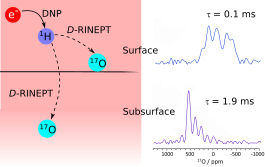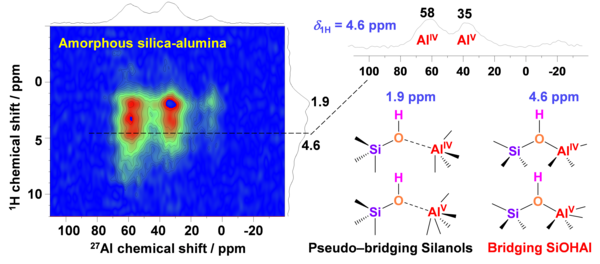
Olivier Lafon
Research topics
Development of solid-state NMR spectroscopy
One of my research topics focuses on the development of novel pulse sequences for solid-state NMR spectroscopy, notably at very high magnetic fields and for the observation of nuclei with spin I ≥ 1 called quadrupolar, which represents 75% of NMR-active isotopes. In particular, we try to observe the local environment of quadrupolar nuclei (27Al, 11B, 35Cl, etc) by probing their proximities with their neighbors. One of the challenge is to observe insensitive quadrupolar nuclei (14N, 17O, 47,49Ti, 67Zn, etc). This research work relies on simulations of spin dynamics and experiments on high-field NMR spectrometers (800, 900 MHz et 1.2 GHz) of Lille NMR facility.
For instance, we developed NMR experiments to observe quadrupolar nuclei with low gyromagnetic ratio near material surfaces using dynamic nuclear polarization (DNP) (see H. Nagashima et al., J. Am. Chem. Soc. 2020, 142, 10659). We notably introduced an efficient NMR technique to transfer DNP-enhanced 1H polarization to quadrupolar nuclei. This approach allowed us to observe insensitive quadrupolar nuclei (17O, 95Mo, 67Zn, 47,49Ti) near the surface of heterogeneous catalysts made of MoO3 supported on TiO2 and semiconducting nanocrystals of zinc oxide.
Unraveling the structure of heterogeneous catalysts and porous materials using NMR
I aim at probing using NMR spectroscopy the structure of adsorption and active sites in sorbents and heterogeneous catalysts (zeolites, metal-organic frameworks (MOF), amorphous silica-alumina, etc) used for applications, such as environmental remediation, etc. High-field solid-state NMR spectroscopy provides key insights into the local environment of metal atoms (27Al, etc).
We were notably able to show the presence of two Brønsted acid sites near the surface of amorphous silica-alumina by probing proximities between protons and 27Al nuclei using 2D NMR experiments at ultra-high magnetic fields (35.2 T, i.e. 1H Larmor frequency of 1.5 GHz) (see J. Phys. Chem. Lett. 2021, 47, 11563).
Understanding the link between structure and dynamics of functional materials and their properties
I use solid-state NMR to understand the relationships between atomic-level structure and dynamics of functional materials and their properties. For instance, in semiconducting nanocrystals called quantum dots, I try to determine the structure of dopants and defects, which influence optoelectronic properties.





